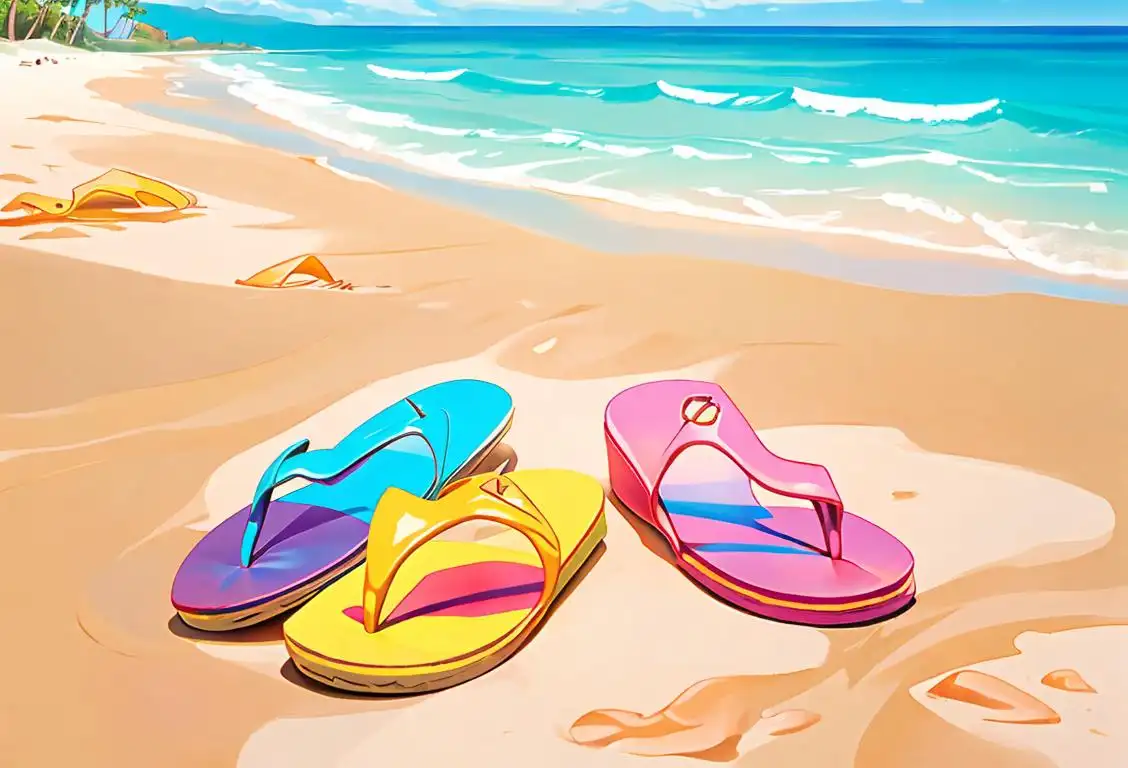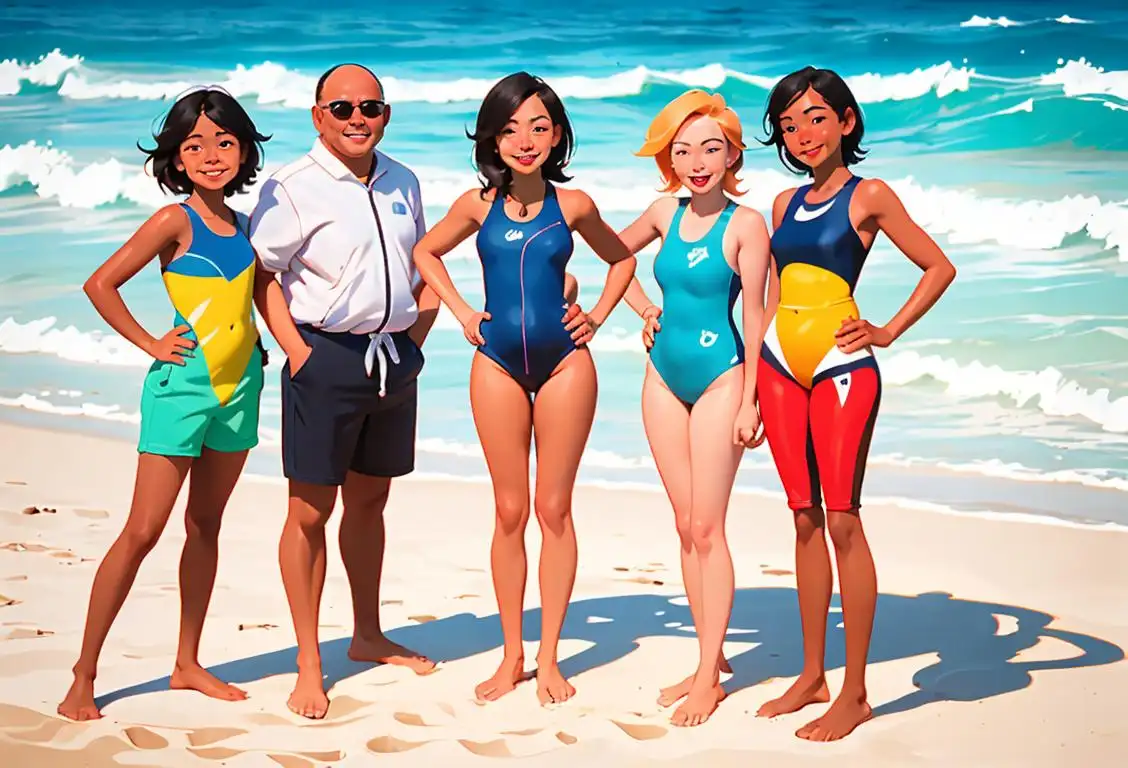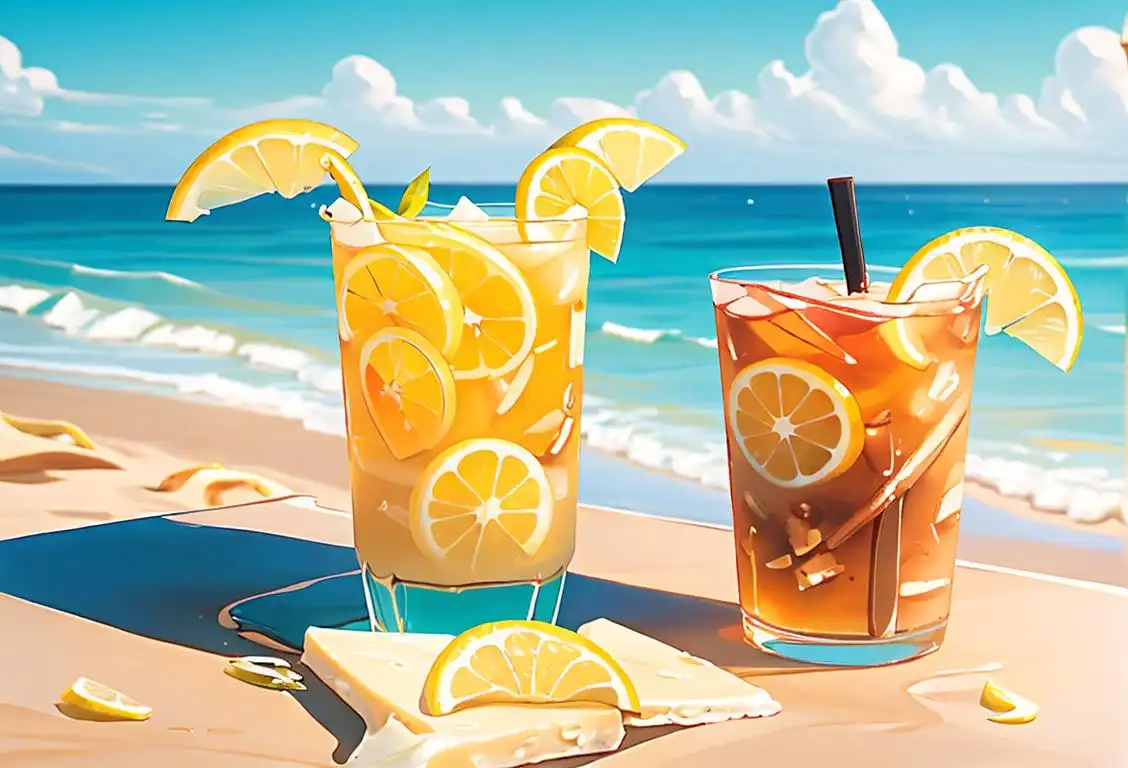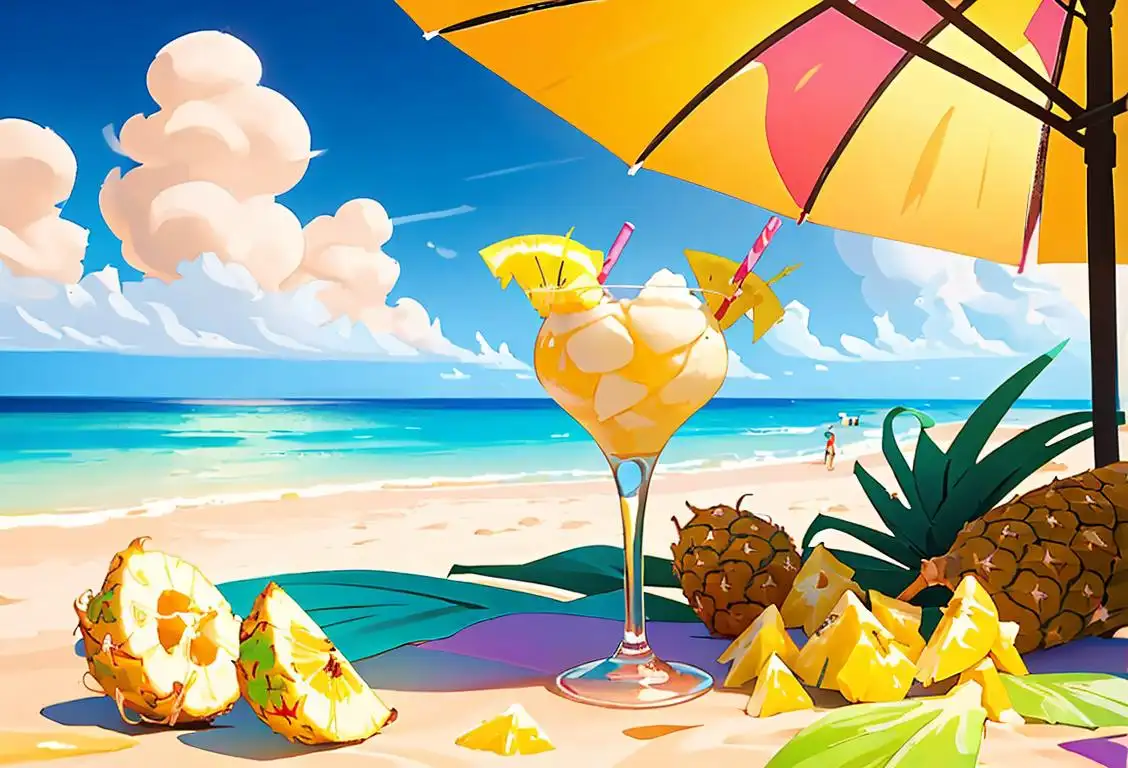National Flip Flops Day

Hey there flip flop fanatics! Are you ready to put on your favorite pair of flippity floppities and celebrate National Flip Flops Day? Get ready for a day of comfy footwear, beach vibes, and laid-back fun!
When is Flip Flops Day?
It's national flip flops day on the 16th June.
The Origins of National Flip Flops Day
Picturing yourself strolling down a sandy beach with the sun kissing your skin and the ocean breeze tousling your hair? That's the perfect scenario to rock a pair of flip flops! But have you ever wondered how this iconic footwear came about?
While flip flops have been around for centuries, they gained immense popularity in the 20th century when they were introduced to the United States. Their origins can be traced back to ancient Egypt, where similar sandals were worn to protect feet from hot sand and prevent infections.
In the United States, flip flops gained mainstream attention in the 1950s, thanks to their association with tropical vacations and leisurely beach trips. These simple, yet practical, shoes quickly became a staple in warm weather wardrobes and a symbol of carefree relaxation.
Celebrating National Flip Flops Day
On this special day, slip into your favorite pair of flip flops and embrace the casual and carefree spirit they represent! Whether you're hitting the beach, lounging by the pool, or simply running errands, flip flops are the ultimate footwear choice for keeping your feet cool and stylish.
Get creative and decorate your flip flops with colorful ribbons, beads, or seashells to make them stand out from the crowd. Or, if you're feeling adventurous, try out a new flip flop design by opting for flip flops with arch support or trendy patterns.
Don't forget to spread the flip flop love! Share pictures of your favorite flip flops on social media using the hashtag #NationalFlipFlopsDay. Let's start a trend and show off our fabulous footwear to the world!
Did You Know?
Did you know that the world's largest pair of flip flops measures a whopping 12 feet long? That's right! Created in 2016, these gigantic flip flops can fit multiple people inside each shoe. Talk about making a big fashion statement!
History behind the term 'Flip Flops'
1930
The Invention of Rubber Flip Flops
The term 'flip flops' originated with the invention of rubber flip flops in the 1930s. These simple, inexpensive sandals featured a rubber sole with two thin straps that go between the toes and around the foot. Initially designed as beach footwear, flip flops quickly gained popularity due to their convenience and comfort.
1933
The Introduction
Flip flops, also known as thongs or jandals, were first introduced to the world in 1933. They were created by a New Zealand shoemaker named Morris Yock. Yock wanted to design a simple and affordable footwear option that would be perfect for the warm weather in New Zealand. He referred to his invention as 'jandals,' which is a combination of the words 'Japanese sandals.' The initial design featured a rubber sole held together by a Y-shaped strap.
1937
The Birth of the Flip Flop
The term 'flip flop' originated in 1937 when the first rubber flip flops were produced by the Brazilian brand Alpargatas. These simple, lightweight sandals became popular due to their comfortable design and affordable price. They were initially known as 'alpargatas' after the brand, but later became widely referred to as 'flip flops' because of the distinctive onomatopoeic sound they made while walking.
1946
The Inventor
In 1946, a Brazilian shoe company called Alpargatas created a comfortable and casual footwear design that would later become known as flip flops. Inspired by traditional Japanese zori sandals, this new shoe style featured a simple rubber sole and thin straps that went between the toes. The inventor of this revolutionary design was Brazilian engineer and businessman, Mário Moreira Filho.
1946
The birth of the modern flip flop
The term 'flip flop' was first used to describe the modern rubber sandal in the year 1946. With its distinctive sound of thong sandals hitting the ground as one walks, the term 'flip flop' perfectly captured the nature of this footwear. These sandals were designed with a simple Y-shaped strap that easily flips and flops with each step, thus earning them their iconic name.
Ancient Egypt
The First Known Sandal
The history of flip flops can be traced back to ancient Egypt, where the first known sandals were created. These early sandals were made from papyrus leaves, plant fibers, and palm leaves. They were simple in design, consisting of a sole attached to the foot with straps or cords.
1946
Birth of the modern flip flop
The modern flip flop as we know it today was born in 1946 in Brazil. Inspired by traditional Japanese sandals called zori, a Brazilian shoe company named Alpargatas decided to create a simplified version of the zori. They used a combination of rubber and canvas straps to create a lightweight and comfortable sandal that was perfect for the hot Brazilian climate.
1950
The Name
In 1950, the term 'flip flop' was coined to describe the distinctive sound made when walking in these particular sandals. The name perfectly captured the onomatopoeic noise produced by the loose rubber soles flapping against the wearer's feet as they moved. This name quickly caught on and became synonymous with this style of footwear.
1950
Mass Production and Global Spread
In the 1950s, mass production techniques were introduced, making flip flops more affordable and widely available. The global spread of flip flops was facilitated by their durability, low cost, and ease of manufacturing. As a result, flip flops became a popular choice in warm climates and beach destinations around the world.
1950
Name change to flip flops
In 1950, the term 'flip flop' was officially coined for this new type of sandal. The name comes from the sound the sandals make when walking in them, as the foot flips and flops on the sole. The term quickly gained popularity and became ingrained in popular culture.
1950s
Adopted by the Beach Culture
In the 1950s, flip flops gained popularity among beachgoers and surfers. They were preferred over traditional shoes because they were easy to slip on and off, allowing for quick changes to suit the active beach lifestyle. The association with leisure and the beach culture led to the widespread adoption of flip flops as a symbol of relaxation and casual style.
1946
Rise to Popularity
In 1946, flip flops gained popularity when they were introduced to the American market. Soldiers returning from World War II brought these simple and comfortable sandals back with them from the Pacific. This exposure to a new style of footwear sparked an interest among the American public, and flip flops became a symbol of casual and laid-back fashion.
Ancient Rome
Roman Influence
During ancient Rome, the popularity of sandals grew, and their design evolved. Roman sandals, known as "soleae," featured a distinctive flat sole and thin leather straps. They were worn by both men and women, and the design spread throughout the Roman Empire.
1950s
Gaining popularity among beachgoers
During the 1950s, flip flops gained immense popularity among beachgoers. The lightweight, breathable design of the sandals was perfect for hot sandy beaches. Additionally, the ease of slipping them on and off made them a convenient choice for those enjoying the seaside. As the trend caught on, flip flops became a staple accessory for a casual and laid-back beach culture.
1960s
Flip flops become a fashion statement
In the 1960s, flip flops transcended their beachwear image and became a fashion statement. Celebrities and fashion icons embraced the casual and carefree nature of flip flops, propelling them into the realm of everyday footwear. With various designs, colors, and patterns available, flip flops became a versatile and trendy choice for both men and women.
1962
Rise in popularity with the Beach Boys' hit song
In 1962, the Beach Boys released their hit single 'Surfin' Safari,' which included the lyrics 'They'll be dancing and a-carrying on/ In the state of Mississippi, in the state of Alabama/ Well, the kids don't flip flop, they always hippity-hop.' This song contributed to the rising popularity of flip flops as a staple footwear choice for beachgoers and surfers.
1960
Popularity Among Surfers
Flip flops gained immense popularity among surfers in the 1960s. Surfers found flip flops convenient to slip on and off before and after hitting the waves. This association with the surfing culture reflected the laid-back, carefree spirit that flip flops came to represent.
1950s
The Birth of Flip Flops
In the 1950s, the modern concept of flip flops as we know them today began to emerge. Their design was inspired by the traditional Japanese sandals called "zori." Flip flops featured a Y-shaped strap that separated the big toe from the other toes, providing more stability and comfort.
1960s
Beach Culture
During the 1960s, flip flops gained popularity as an essential accessory for beachgoers. The laid-back and carefree nature of these sandals perfectly aligned with the relaxed beach culture of the time. Young people embraced flip flops as a symbol of leisure and an expression of freedom, making them a staple of summer fashion.
1960s
Havaianas Revolution
During the 1960s, a major revolution in flip flop design took place. Havaianas, a Brazilian brand, launched a line of flip flops that featured a rice-straw texture on the footbed. This unique texture not only added a element of style but also enhanced grip and comfort. Havaianas quickly became a must-have accessory among Brazilians and gained popularity worldwide.
1960s
Expanding Market and Material Innovation
During the 1960s, flip flops continued to soar in popularity. Their affordability and lightweight design made them accessible to people of all ages and socioeconomic backgrounds. Manufacturers also started experimenting with different materials, such as foam and plastic, to enhance comfort and durability. This period saw the rise of flip flop brands targeting diverse consumer segments.
1970s
Fashion Staple
In the 1970s, flip flops made their way from the beach to mainstream fashion. Designers recognized the comfort and versatility of these sandals, incorporating them into their collections. Celebrities and fashion icons popularized flip flops as a chic footwear option, elevating them from a casual beach essential to a stylish fashion staple.
1970s
Fashion Statements and Variations
In the 1970s, flip flops further evolved as a fashion statement. The Hollywood culture embraced flip flops, and various celebrities were spotted wearing them on and off the screen. Designs became more fashionable, incorporating bright colors, patterns, and embellishments. The casual nature of flip flops blended with the growing demand for comfortable and versatile footwear.
2000s
Fashionable Footwear
In the 2000s, flip flops transcended their casual beachwear status and became a fashionable footwear choice. Luxury brands like Chanel and Hermès started incorporating flip flops into their high-end collections, elevating the humble footwear to a fashion staple. Designers experimented with various materials, embellishments, and colors, transforming flip flops into versatile footwear suitable for both casual and formal occasions.
1960s
Popularity Boom
In the 1960s, flip flops became widely popular in the United States, especially among the younger generation. They were considered casual and comfortable footwear, perfect for the beach, poolside, or just lounging around. Their low cost and ease of use contributed to their widespread adoption.
1970
Fashion Acceptance and Stylish Variations
During the 1970s, flip flops transitioned from beachwear to a fashionable footwear choice. Designers started experimenting with different materials and styles, giving rise to more stylish variations of flip flops. They were no longer limited to rubber and began incorporating leather, fabric, and embellishments, further enhancing their appeal.
1970s
Global popularity and brand competition
By the 1970s, flip flops had gained global popularity, reaching every corner of the world. Multiple brands emerged, each aiming to offer unique designs and features for this beloved footwear. Brands like Havaianas from Brazil and Reef from the United States gained a significant market share, further solidifying the popularity and versatility of flip flops.
1970s
Global expansion and diverse designs
During the 1970s, flip flops went global, spreading to various countries and cultures. The design of flip flops also started to diversify, with different materials, patterns, and colors being used. Flip flops became associated with leisure, relaxation, and laid-back lifestyles, appealing to people of all ages.
2000
Celebrity Endorsement and High-End Brands
In the early 2000s, flip flops experienced a surge in popularity with celebrity endorsements and high-end brands entering the market. Celebrities frequently spotted wearing flip flops in public solidified their status as a fashionable and trendy footwear choice. Luxury brands started producing designer flip flops, elevating them from casual beachwear to a fashionable accessory.
Present
A Global Phenomenon
Today, flip flops are a global phenomenon and are worn by people of all ages and backgrounds. They have become a part of everyday fashion in many countries, especially during the summer months. From trendy beach destinations to urban sidewalks, flip flops are considered a comfortable and convenient footwear choice. With numerous brands offering a wide range of styles and designs, flip flops continue to evolve, maintaining their status as a beloved and versatile footwear option.
2000s
Global Popularity and Cultural Influence
By the 2000s, flip flops had become a global phenomenon. They were no longer limited to beachwear but were also worn in everyday settings, schools, and even workplaces in some regions. The term 'flip flops' had transcended borders and languages, becoming a universally recognized name for this iconic footwear. Their popularity and cultural significance continue to thrive in modern society.
2000s
Evolution of flip flop styles
In the 2000s, flip flop styles evolved beyond the traditional rubber design. While the classic rubber flip flops remained popular, new materials and technologies incorporated into the footwear allowed for increased comfort and durability. Additionally, embellishments, such as rhinestones, beads, and unique prints, added a touch of personal style to these summer staples.
2000s
Colorful Variations
Starting from the early 2000s, flip flops underwent a surge in popularity and a burst of creativity. New materials, patterns, and colors emerged, allowing people to express their individuality through their footwear choices. From basic rubber flip flops to vibrant, embellished designs, there became a flip flop style for every occasion, further cementing their position as a beloved and versatile footwear option.
2000s
Fashionable flip flop trend
In the early 2000s, flip flops experienced a surge in popularity as a fashionable footwear choice. Luxury fashion brands started creating their own versions of flip flops, using high-end materials and adding stylish embellishments. Flip flops became acceptable to wear in more formal settings, including weddings and parties.
2000s
Fashionable Rise
In the 2000s, flip flops transcended their casual reputation and entered the fashion world. High-end designers began creating stylish and luxurious versions of flip flops, adorned with embellishments, patterns, and premium materials. They became a popular footwear choice for both casual and semi-formal occasions.
Present
Iconic Symbol of Relaxation and Casual Comfort
Today, flip flops have become an iconic symbol of relaxation, informality, and casual comfort. They are widely popular during the summer months and in tropical locations. Flip flops are seen as a versatile footwear option, suitable for both beach outings and casual everyday wear, reflecting their enduring cultural significance.
Present
Continued popularity and innovation
Today, flip flops remain incredibly popular worldwide. They continue to evolve with new technologies and materials, such as memory foam soles and eco-friendly options. Flip flops are not only seen as a practical footwear choice but also as a fashion statement that symbolizes summer, relaxation, and a carefree lifestyle.
Did you know?
Did you know that the world's largest pair of flip flops measures a whopping 12 feet long? That's right! Created in 2016, these gigantic flip flops can fit multiple people inside each shoe. Talk about making a big fashion statement!Tagged
fun fashion summerFirst identified
19th June 2015Most mentioned on
16th June 2017Total mentions
32Other days
Bikini Bikini Day
Swimsuit Day
Shorts Day
Short Shorts Day
Flip Flops Day
Iced Tea Day
Pina Colada Day
Flip Flop Day
Hat Day
Dress Like Your Inner Hoe Day







